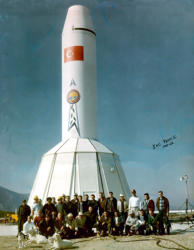HISTORY - Page 58
engines were down rated by ABMA from 150,000 pounds to 135,000 pounds because the turbopump was
not satisfactory. NAA was already in the process of modifying this unit, and two pumps were subjected to
prolonged tests with satisfactory results. However, because of the critical supply of these engines, the first
JUPITER missiles had to fly with the lower thrust units. In fact, while procuring the first four flyable units,
the situation was far from being satisfactory to ABMA. For one thing, procurement had to be effected
through WDD, which caused an undue administrative workload. Then, the uncovering of the technical
design deficiencies created a severe problem in assuring the timely delivery of spare parts and
modification kits. One problem had, in turn, created another. NAA was supposed to have been able to ship
the missiles completely modified to ABMA in January 1957, but it was several months after that. Engine
modifications of late 1956 and 1957, however, appeared to be quite successful. This was aptly
demonstrated in one instance during a static test at NAA, when a unintended overrun to 195,000 pounds of
thrust happened. The turbopump and the thrust chamber did not show any damage
77
. From time to time,
however, technical problems, including the turbopump, did crop up.
Another major propulsion system problem concerned propellant sloshing. This condition was uncovered
during the firing of JUPITER IB, the second JUPITER missile fired. After a normal liftoff and up to 70 seconds,
the flight program was normal, but then oscillations in pitch and yaw began to build up and the missile
disintegrated at 93 seconds. Heavy instrumentation immediately located the difficulty, and data showed
_____________________________







(77) Ibid.; JUP Prog Rept for Apr 57, undated; JUP Prog Rpt for Aug 57, 6 Sep 57, Hist Off files.



Jupiter SM-78 Weapon System
I&C Team 2, Çigli AB, Turkey 1961-1962 Chrysler Corporation Missile Division

HISTORY - Page 58
engines were down rated by ABMA from 150,000
pounds to 135,000 pounds because the turbopump was
not satisfactory. NAA was already in the process of
modifying this unit, and two pumps were subjected to
prolonged tests with satisfactory results. However,
because of the critical supply of these engines, the
first JUPITER missiles had to fly with the lower thrust
units. In fact, while procuring the first four flyable
units, the situation was far from being satisfactory to
ABMA. For one thing, procurement had to be effected
through WDD, which caused an undue administrative
workload. Then, the uncovering of the technical design
deficiencies created a severe problem in assuring the
timely delivery of spare parts and modification kits.
One problem had, in turn, created another. NAA was
supposed to have been able to ship the missiles
completely modified to ABMA in January 1957, but it
was several months after that. Engine modifications of
late 1956 and 1957, however, appeared to be quite
successful. This was aptly demonstrated in one
instance during a static test at NAA, when a
unintended overrun to 195,000 pounds of thrust
happened. The turbopump and the thrust chamber did
not show any damage
77
. From time to time, however,
technical problems, including the turbopump, did crop
up.
Another major propulsion system problem concerned
propellant sloshing. This condition was uncovered
during the firing of JUPITER IB, the second JUPITER
missile fired. After a normal liftoff and up to 70
seconds, the flight program was normal, but then
oscillations in pitch and yaw began to build up and the
missile disintegrated at 93 seconds. Heavy
instrumentation immediately located the difficulty,
and data showed
_____________________________
(77) Ibid.; JUP Prog Rept for Apr 57, undated; JUP Prog Rpt for Aug 57, 6 Sep 57, Hist Off files.





















